A New Kind of Mathematics Course
Recently, the #ShutDownSTEM initiative called for a day of personal and institutional reflection on June 10, 2020, to contemplate the historical and present barriers to inclusion, representation and opportunities in STEM communities and encourage public commitments for both individual and institutional changes and actions. The American Mathematical Society used this day to develop a list of initial outcomes and outline their action plan. In this spirit, we want to highlight one of the department’s efforts to critically examine the role of mathematics, the mathematical community and society via our new course offering Math 2010S Intersections of Mathematics and Society: Hidden Figures.
This course was inspired by Margot Lee Shetterly’s book Hidden Figures: The American Dream and the Untold Story of the Black Women Mathematicians Who Helped win the Space Race, which was turned into an awarding-winning film of the same name. The goal of this course is to use the story of the Hidden Figures in the book to study diversity and inclusion in mathematical communities and better understand the mathematical tools used during the Space Race. Students are paired with local STEM leaders to learn how their personal and professional communities have aided in their careers and how to describe the specialized tools used in their work. Ultimately, at the end of the course students should be able to answer the question:
What can I do with quantitative training outside of academia, and what communities should I be a part of to help me get where I want to go?
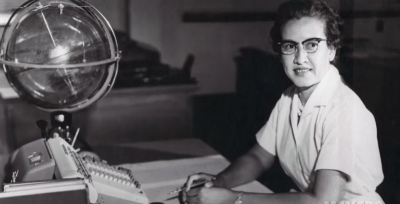
Figure 1: Katherine Johnson at work (with mechanical computer and celestial globe) Source:
In the course we studied the juxtaposition of scientific versus social progress while gaining insight into the stories of the primary characters of the text. One of the most celebrated was Katherine Johnson, a mathematical powerhouse whose computations were critical to the success of the early U.S. space missions. Johnson passed away on February 24, 2020, at the age of 101.
A core goal for the course is for students to use the Hidden Figures story to understand how doing mathematics in the midst of a vibrant and inclusive community can yield significant scientific, mathematical and societal advances. This past year, students reflected on their own experiences in the STEM community. One student noted:
“The entire story has completely reshaped [my] look on life in STEM. … Every day in this class and every week after reading the chapters, I would get a surge of ‘math adrenaline,’ and I had the realization that I loved math, I just hated the community I was a part of originally. Reading this book and being in class is the first time in 3.5 semesters that I finally felt like I belonged in STEM and I could do great things in the community.”
The course utilized the discussion board and survey features of Carmen weekly. The following quotes were taken from a reflection prompt about the impact of the Hidden Figures story.
“The vast nature of the scientific contributions made by the women described in this book resonates with me the most.”
“The parts of Hidden Figures that have resonated with me the most have mainly been about the advocacy, representation, confidence, sense of community and personal drive that each of the women had in our story. … Additionally, I like how Katherine Johnson never let anything deter her or interrupt her progress while working. She also didn't give anyone power over her in situations where [she] faced discrimination. I feel like this allowed Katherine Johnson to excel and focus on her work solely, and a lot can be learned from her character.”
During the first part of the semester, students learned about the origins of the National Advisory Council on Aeronautics (NACA) that predated NASA and some of the mathematical tools used at the onset of the Space Race. They learned how to operate engineering grade Post 1460 Versalog slide rules, which were used as computational devices by computers at NACA as well as by astronauts in the early space missions.
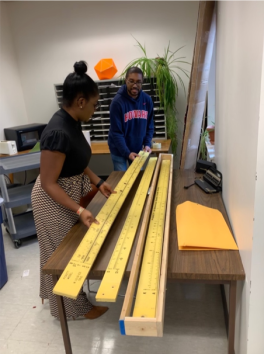
Figure 2: Ranthony A.C. Edmonds and John Johnson manipulate pieces of an 8 ft demonstration slide rule. Students learned how to operate a slide rule as part of the course.
They also learned how to operate Addiators, simple devices that allow for addition, and sometimes subtraction, of large numbers. One student noted the following in a reflection prompt:
“The slide rule can carry out many different functions, and for me it was particularly difficult differentiating each of the functions from the others. It has taken consistent use and practice to get comfortable performing each of the functions without getting mixed up. Another, much less complicated skill that I've had to develop is the use of the Addiator, which I am proud to have figured out on my own.”
Community Partnerships
Math 2010S is the first service-learning course offered by the Department of Mathematics. The course has partnered with the Columbus Metropolitan Library (CML) so students can deliver original STEM programming to library patrons to help fulfill CML’s Young Minds Initiative. Kelli Bates, the director of the Young Minds Initiative, came to the first week of class to talk about how to best interact with students of various backgrounds at the library branches.
One of the goals of participating in the service learning component of Math 2010S is for students to improve their mathematical communication. In a mid-semester survey, students were asked, “What skills have you developed (or sharpened) during the development of your programming for the CML up to this point?” Here’s what one student had to say:
“One of the most crucial skills I have developed during the programming for the CML up to this point is learning how to communicate and explain mathematics in the simplest terms possible. Due to this, I’ve learned that it’s more effective to explain mathematics, and any concepts in general, [in ways] that best suit your audience…Trying to communicate your topic in the simplest terms also allows you to determine how well you actually understand the material and allows you to assess whether or not you need to revisit certain aspects of your topic again.”
Due to COVID-19, the students changed their original plan to deliver their programming at library branches and instead created a program kit for the libraries that included instructions for appropriately-trained personnel to administer the activity.
They developed an interactive activity where library patrons would participate in a Top-Secret NASA mission. To determine the launch codes of a rocket, the students would first master two training modules through which they would learn how to use Addiators and slide rules, and then learn more information about Katherine Johnson and Dorothy Vaughan, two of the primary characters from the Hidden Figures text.

Figure 3: Graphic created by Math 2010S students for the CML Program Kit.
Meet Local Hidden Figures
Students were paired with local STEM leaders whom they interviewed throughout the semester to learn about their personal and mathematical backgrounds and to better understand the mathematical tools they used in their work. The goal of these interactions was to provide insight into a variety of careers outside of academia for those with quantitative training.
Lynette Campbell, MS
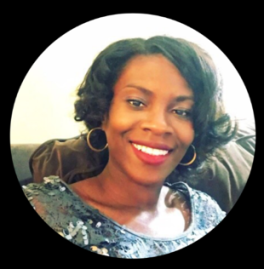
Figure 4: Lynette Campbell MS
Lynette Campbell is an engineering coordinator and project leader for Honda Engineering, a subsidiary of Honda Manufacturing located in Marysville, Ohio. She manages automation equipment projects for assembly, paint, plastics and vehicle quality areas of all North American Plants. Prior to this, Campbell worked for eight years as a production engineer, process engineer, and new model development engineer in the powertrain and paint departments at Toyota Motor Manufacturing Kentucky. Students enjoyed learning about the Catia 3D software and mathematical modeling she uses in her work.
Campbell is a native of Columbus, OH and attended Independence High School where her teachers inspired her to pursue mathematics. She has an undergraduate degree in mathematics from Kentucky State University and a master’s degree in mechanical engineering from The Ohio State University. She is a mother of two girls and enjoys volunteering in the community in various STEM activities.
Dr. Anahi Ortiz
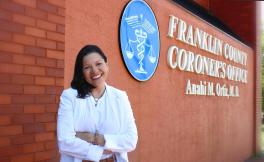
Figure 5: Dr. Anahi Ortiz
Dr. Anahi Ortiz is the appointed coroner for Franklin County and has served in this role since 2014. She has worked to decrease the number of opioid-related overdose deaths, and prior to this appointment she practiced as a physician for almost 30 years specializing in pediatrics. Currently, she is on the boards of Netcare, the Franklin County Suicide Prevention Coalition, the YMCA Medical Advisory Board, and Project Butterfly. Students enjoyed learning about the measurement conversions and data visualization techniques she uses in her work.
Dr. Ortiz grew up in New York City and was inspired to pursue a career in STEM due to her mother’s interest and love of mathematics. She attended the Sophie Davis School of Biomedical Education, a six-year BS/MD program in New York City with a mission to train physicians to work in underserved communities. She has used this training to provide preventative care and education to underserved communities.
Kehinde Salau
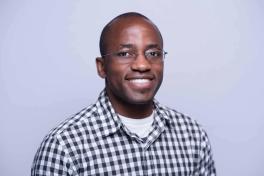
Figure 6: Dr. Kehinde Salau
Kehinde ‘Kenny’ Salau is a quantitative model developer at JPMorgan Chase (JPMC) where he works with the Consumer and Community Bank Deposits Modeling Group. He helps JPMC make informed decisions about deposit growth, attrition and mortgage production by providing analytics support via forecasting, customer propensity modeling and developing test designs for the efficacy of marketing tactics. Prior to this, he completed at three-year postdoc at the University of Arizona where he studied discrete-time equations and mathematical ecology. Students enjoyed learning about the techniques of logistic regression, data visualization and mathematical modeling via R and Python he uses in his work.
Salau was born in Lagos, Nigeria, and his family moved to the United States when he was 12 years old. He has an undergraduate degree in mathematics from St. Mary’s College, and he earned a masters and doctoral degree in applied mathematics from Arizona State University.
Future Directions
Math 2010S (formerly Math 2194 during Spring 2020) will be offered again in autumn 2020. Seats are still available, so please encourage interested students to enroll! The course satisfies the Service Learning, Open Option GE. The prerequisites are a grade of C- or above in 1148 and 1149, a grade of C- or above in 1150, or Math Placement Level L.
Math 2010S will be expanding its community partnerships for future offerings of the course and anticipates announcing two new partners in autumn 2020! The service-learning component of the course will be modified as necessary to account for limited face-to-face opportunities.
Also, we continue to recruit those within the Columbus Metro area with mathematical training to serve as local Hidden Figures and/or guest lecturers during the semester. Our aim is to have as much professional diversity as possible, and we welcome those who are interested in the course and communicating their experiences and expertise with our students.
If you know of potential Hidden Figures for the course, have any questions or would like to be involved in any way, please contact Dr. Edmonds(.110) or Dr. Johnson(.5316) or visit the course website at math.osu.edu/courses/2010s.
